Decarbonising the Shipping Sector: A Critical Analysis on the Application of Waste Heat for Refrigeration in Fishing Vessels
Abstract
:Featured Application
Abstract
1. Introduction
2. Methodology
3. Identification of Boundary Conditions
3.1. Fishing Vessels
3.2. Seawater Conditions
3.3. Calculation of Cooling Demand
3.4. Available Waste Heat from Engine
4. The Refrigeration Systems
- Activated carbon/ethanol;
- CaCl2/ammonia.
5. Integration of Sorption Systems On-board
5.1. Cascade System
5.2. Cascade System with Pre-Conditioning
5.3. Series Hybrid System
5.4. Feasibility Evaluation of Integrated Configurations
- -
- Thermal COP, the ratio between the cooling energy delivered and the driving heat needed:
- -
- EER (energy efficiency ratio), the ratio of the cooling energy delivered over the electricity needed to drive auxiliaries:
- -
- The SCP (specific cooling power), i.e., the normalized cooling power per unit of sorbent that the chiller can deliver:
- The use of the AC/ethanol system for fishing vessel A in the Indian Ocean (since this is the most critical condition, due to the higher temperature of the water) and in vessel C in the North Sea for series configuration;
- The use of the CaCl2/ammonia system for cascade configuration, for all vessels in the North Sea and Indian Ocean conditions.
6. Energy Analysis
6.1. Cascade Configuration
6.2. Series Configuration
7. Environmental Analysis
8. Future Trends and Alternatives
Author Contributions
Funding
Conflicts of Interest
References and Note
- IMO Third IMO GHG Study. Available online: http://www.imo.org/en/OurWork/Environment/PollutionPrevention/AirPollution/Pages/Greenhouse-Gas-Studies-2014.aspx (accessed on 19 September 2019).
- Thomas, G.; O’Doherty, D.; Sterling, D.; Chin, C. Energy audit of fishing vessels. Proc. Inst. Mech. Eng. Part M J. Eng. Marit. Environ. 2010, 224, 87–101. [Google Scholar] [CrossRef]
- IMO Energy Efficiency Measures. Available online: http://www.imo.org/en/OurWork/Environment/PollutionPrevention/AirPollution/Pages/Technical-and-Operational-Measures.aspx (accessed on 19 September 2019).
- Bouman, E.A.; Lindstad, E.; Rialland, A.I.; Strømman, A.H. State-of-the-art technologies, measures, and potential for reducing GHG emissions from shipping—A review. Transp. Res. Part D Transp. Environ. 2017, 52, 408–421. [Google Scholar] [CrossRef]
- Baldi, F.; Ahlgren, F.; Nguyen, T.-V.; Thern, M.; Andersson, K. Energy and Exergy Analysis of a Cruise Ship. Energies 2018, 11, 2508. [Google Scholar] [CrossRef]
- Ancona, M.A.; Baldi, F.; Bianchi, M.; Branchini, L.; Melino, F.; Peretto, A.; Rosati, J. Efficiency improvement on a cruise ship: Load allocation optimization. Energy Convers. Manag. 2018, 164, 42–58. [Google Scholar] [CrossRef]
- Larsen, U.; Sigthorsson, O.; Haglind, F. A comparison of advanced heat recovery power cycles in a combined cycle for large ships. Energy 2014, 74, 260–268. [Google Scholar] [CrossRef]
- Shu, G.; Liang, Y.; Wei, H.; Tian, H.; Zhao, J.; Liu, L. A review of waste heat recovery on two-stroke IC engine aboard ships. Renew. Sustain. Energy Rev. 2013, 19, 385–401. [Google Scholar] [CrossRef]
- Parker, R.W.R.; Tyedmers, P.H. Fuel consumption of global fishing fleets: Current understanding and knowledge gaps. Fish Fish. 2015, 16, 684–696. [Google Scholar] [CrossRef]
- Xu, X.; Li, Y.; Yang, S.; Chen, G. A review of fishing vessel refrigeration systems driven by exhaust heat from engines. Appl. Energy 2017, 203, 657–676. [Google Scholar] [CrossRef]
- Wang, R.Z. Efficient adsorption refrigerators integrated with heat pipes. Appl. Therm. Eng. 2008, 28, 317–326. [Google Scholar] [CrossRef]
- Gullì, G.; Sapienza, A.; Caprì, A.; Costa, F.; La Rosa, D.; Palomba, V.; Freni, A. Innovative adsorption chiller for marine applications: Design and building. Energy Procedia 2015, 82, 432–438. [Google Scholar] [CrossRef]
- Ge, Z.; Li, J.; Duan, Y.; Yang, Z.; Xie, Z. Thermodynamic Performance Analyses and Optimization of Dual-Loop Organic Rankine Cycles for Internal Combustion Engine Waste Heat Recovery. Appl. Sci. 2019, 9, 680. [Google Scholar] [CrossRef]
- Cao, T.; Lee, H.; Hwang, Y.; Radermacher, R.; Chun, H.-H. Performance investigation of engine waste heat powered absorption cycle cooling system for shipboard applications. Appl. Therm. Eng. 2015, 90, 820–830. [Google Scholar] [CrossRef]
- Palomba, V.; Dawoud, B.; Sapienza, A.; Vasta, S.; Frazzica, A. On the impact of different management strategies on the performance of a two-bed activated carbon/ethanol refrigerator: An experimental study. Energy Convers. Manag. 2017, 142, 322–333. [Google Scholar] [CrossRef]
- Lu, Z.; Wang, R. Experimental performance study of sorption refrigerators driven by waste gases from fishing vessels diesel engine. Appl. Energy 2016, 174, 224–231. [Google Scholar] [CrossRef]
- Salmi, W.; Vanttola, J.; Elg, M.; Kuosa, M.; Lahdelma, R. Using waste heat of ship as energy source for an absorption refrigeration system. Appl. Therm. Eng. 2017, 115, 501–516. [Google Scholar] [CrossRef]
- Sapienza, A.; Gullì, G.; Calabrese, L.; Palomba, V.; Frazzica, A.; Brancato, V.; La Rosa, D.; Vasta, S.; Freni, A.; Bonaccorsi, L.; et al. An innovative adsorptive chiller prototype based on 3 hybrid coated/granular adsorbers. Appl. Energy 2016, 179, 929–938. [Google Scholar] [CrossRef]
- Frazzica, A.; Palomba, V.; Dawoud, B.; Gullì, G.; Brancato, V.; Sapienza, A.; Vasta, S.; Freni, A.; Costa, F.; Restuccia, G. Design, realization and testing of an adsorption refrigerator based on activated carbon/ethanol working pair. Appl. Energy 2016, 174, 15–24. [Google Scholar] [CrossRef]
- Palomba, V.; Aprile, M.; Motta, M.; Vasta, S. Study of sorption systems for application on low-emission fishing vessels. Energy 2017, 134, 554–565. [Google Scholar] [CrossRef]
- Sapienza, A.; Palomba, V.; Gullì, G.; Frazzica, A.; Vasta, S. A new management strategy based on the reallocation of ads-/desorption times: Experimental operation of a full-scale 3 beds adsorption chiller. Appl. Energy 2017, 205, 1081–1090. [Google Scholar] [CrossRef]
- Cao, T.; Lee, H.; Hwang, Y.; Radermacher, R.; Chun, H.-H. Modeling of waste heat powered energy system for container ships. Energy 2016, 106, 408–421. [Google Scholar] [CrossRef]
- Palomba, V.; Aprile, M.; Vasta, S.; Gullì, G.; Freni, A.; Motta, M. Study and Evaluation of Two Innovative Waste-heat Driven Refrigeration Systems for Fishing Vessels Applications. Energy Procedia 2016, 101, 838–845. [Google Scholar] [CrossRef]
- Maeda, S.; Thu, K.; Maruyama, T.; Miyazaki, T. Critical Review on the Developments and Future Aspects of Adsorption Heat Pumps for Automobile Air Conditioning. Appl. Sci. 2018, 8, 2061. [Google Scholar] [CrossRef]
- Prasath, K.; Wimalasiri, W.K. Development of Multi Multi-Day Boat Day Designs with Mechanical Refrigeration Facility; Final Report; Project Funded by National Aquatic Resource and Development Agency (NARA): Colombo, Sri Lanka, 2017. [Google Scholar]
- Johnston, W.A. Freezing and Refrigerated Storage in Fisheries; Food and Agriculture Organization of the United Nations: Rome, Italy, 1994; ISBN 9251035792. [Google Scholar]
- Torquati, N. Lettura Statistica Della Pesca Italiana; Technical Report; San Benedetto del Tronto: Tronto, Italy, 2013. [Google Scholar]
- CIEM, I. Greater North Sea Ecoregion—Fisheries Overview; ICES: Copenhagen, Denmark, 2018. [Google Scholar]
- De Young, C.; Food and Agriculture Organization of the United Nations. Review of the State of World Marine Capture Fisheries Management: Indian Ocean; Food and Agriculture Organization of the United Nations: Rome, Italy, 2006; ISBN 9251054991. [Google Scholar]
- MODIS Water Surface Temperature. Available online: https://neo.sci.gsfc.nasa.gov/view.php?datasetId=MYD28M (accessed on 21 May 2019).
- Galbraith, P.S.; Larouche, P.; Chassé, J.; Petrie, B. Sea-surface temperature in relation to air temperature in the Gulf of St. Lawrence: Interdecadal variability and long term trends. Deep Sea Res. Part II Top. Stud. Oceanogr. 2012, 77–80, 10–20. [Google Scholar] [CrossRef]
- Elg, M.; Kuosa, M.; Tammi, K.; Mäkipeska, P.; Kinnunen, A.; Rahkola, P. Supporting the energy efficient ship design with energy flow simulations: Case efficient cooling water system. In Proceedings of the Energy Efficient Ships 2015, Rotterdamn, The Netherlands, 3–6 November 2015. [Google Scholar]
- Fernández-Seara, J.; Vales, A.; Vázquez, M. Heat recovery system to power an onboard NH3-H2O absorption refrigeration plant in trawler chiller fishing vessels. Appl. Therm. Eng. 1998, 18, 1189–1205. [Google Scholar] [CrossRef]
- De Larminat, P. Cold Chain Brief on Transport Refrigeration. In Proceedings of the MOP-27 Side Event, Dubai, United Arab Emirates, 1 November 2015. [Google Scholar]
- Bellos, E.; Tzivanidis, C. CO2 Transcritical Refrigeration Cycle with Dedicated Subcooling: Mechanical Compression vs. Absorption Chiller. Appl. Sci. 2019, 9, 1605. [Google Scholar] [CrossRef]
- Gibelhaus, A.; Fidorra, N.; Lanzerath, F.; Bau, U.; Köhler, J.; Bardow, A. Hybrid refrigeration by CO2 vapour compression cycle and water-based adsorption chiller: An efficient combination of natural working fluids Froid hybride par cycle à compression de vapeur au CO2 et refroidisseur à adsorption d’eau: Une combinaison ef. Int. J. Refrig. 2019, 103, 204–214. [Google Scholar] [CrossRef]
- Pearson, A.B. CO2 as a Refrigerant; International Institute of Refrigeration: Paris, France, 2014; ISBN 9782362150050. [Google Scholar]
- Loss Prevention Briefing; North Service, Strenght, Quality, The North of England P&I Association. The Quayside, Newcastle upon Tyne, NE1 3DU, UK. (file:///C:/Users/Frazzica/Downloads/Fishing-Vessels-Refrigeration-Jan-2016-LP-Briefing.pdf.pdf) 2016.
- Dwyer, T. Going transcritical with CO2. CIBSE J. 2012. Available online: https://www.cibsejournal.com/cpd/modules/2012-12/ (accessed on 27 November 2019).
- Vasta, S.; Palomba, V.; La Rosa, D.; Mittelbach, W. Adsorption-compression cascade cycles: An experimental study. Energy Convers. Manag. 2018, 156, 365–375. [Google Scholar] [CrossRef]
- Cyklis, P. Two stage ecological hybrid sorption–compression refrigeration cycle. Int. J. Refrig. 2014, 48, 121–131. [Google Scholar] [CrossRef]
- Palomba, V.; Varvagiannis, E.; Karellas, S.; Frazzica, A. Hybrid Adsorption-Compression Systems for Air Conditioning in Efficient Buildings: Design through Validated Dynamic Models. Energies 2019, 12, 1161. [Google Scholar] [CrossRef]
- Palomba, V.; Wittstadt, U.; Bonanno, A.; Tanne, M.; Harborth, N.; Vasta, S. Components and design guidelines for solar cooling systems: The experience of ZEOSOL. Renew. Energy 2019, 141, 678–692. [Google Scholar] [CrossRef]
- IMO. RESOLUTION MEPC. 282(70) (Adopted on 28 October 2016) GUIDELINES FOR THE DEVELOPMENT OF A SHIP ENERGY EFFICIENCY MANAGEMENT PLAN (SEEMP); IMO: London, UK, 2016.
- International Energy Agency. The Future of Cooling: Opportunities for Energy-Efficient Air Conditioning; International Energy Agency: Paris, France, 2018. [Google Scholar]
- Baldi, F.; Johnson, H.; Gabrielii, C.; Andersson, K. Energy and exergy analysis of ship energy systems—the case study of a chemical tanker. Int. J. Thermodyn. 2015, 18, 82. [Google Scholar] [CrossRef] [Green Version]
- Frazica, A.; Palomba, V.; Brancato, V.; Freni, A.; Manzan, M. Numerical simulation and experimental analysis of a latent thermal energy storage for naval applications. In Proceedings of the Eurotherm Seminar 112—Advances in Thermal Energy Storage 2019, Lleida, Spain, 15–17 May 2019. [Google Scholar]

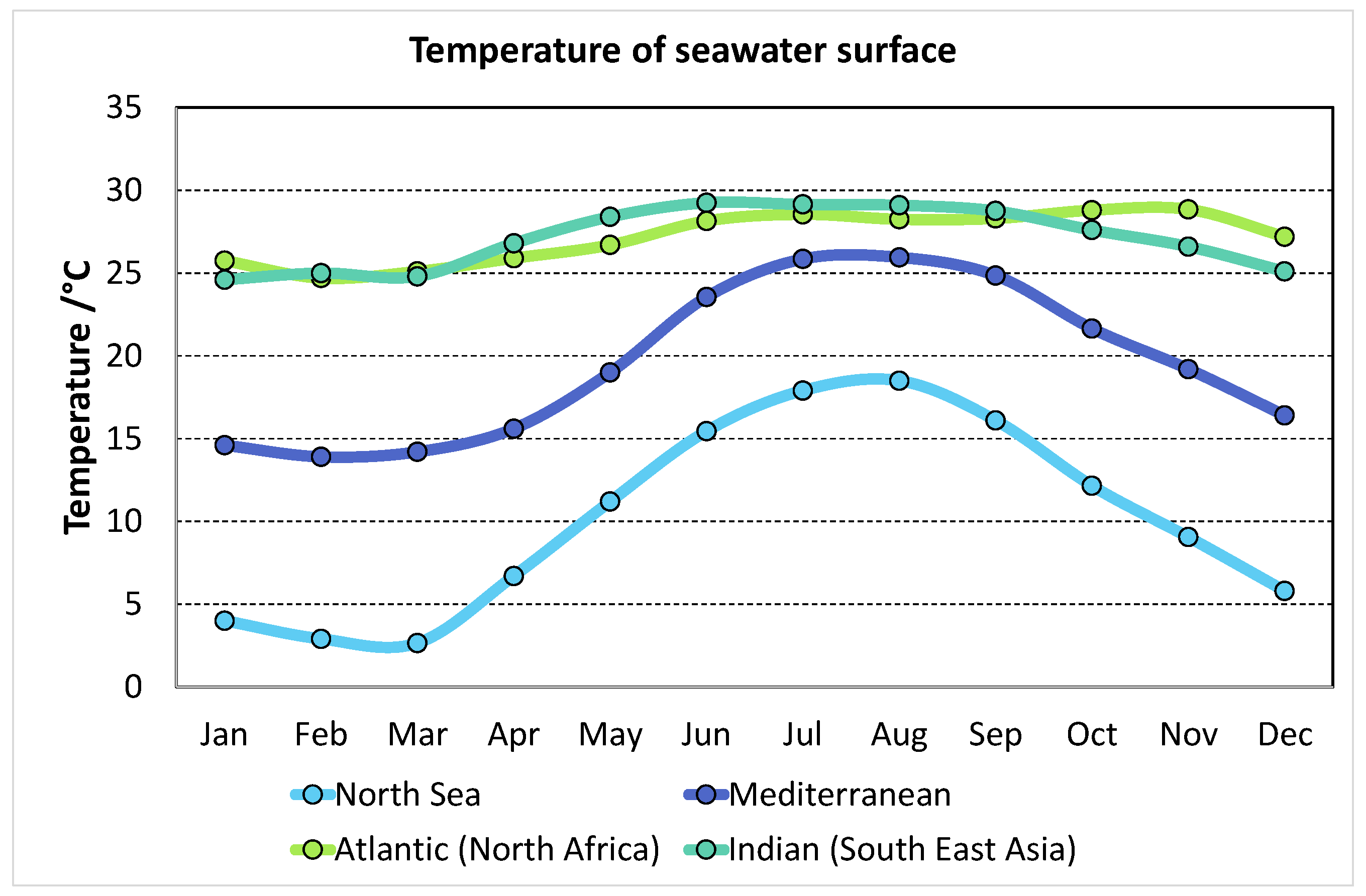
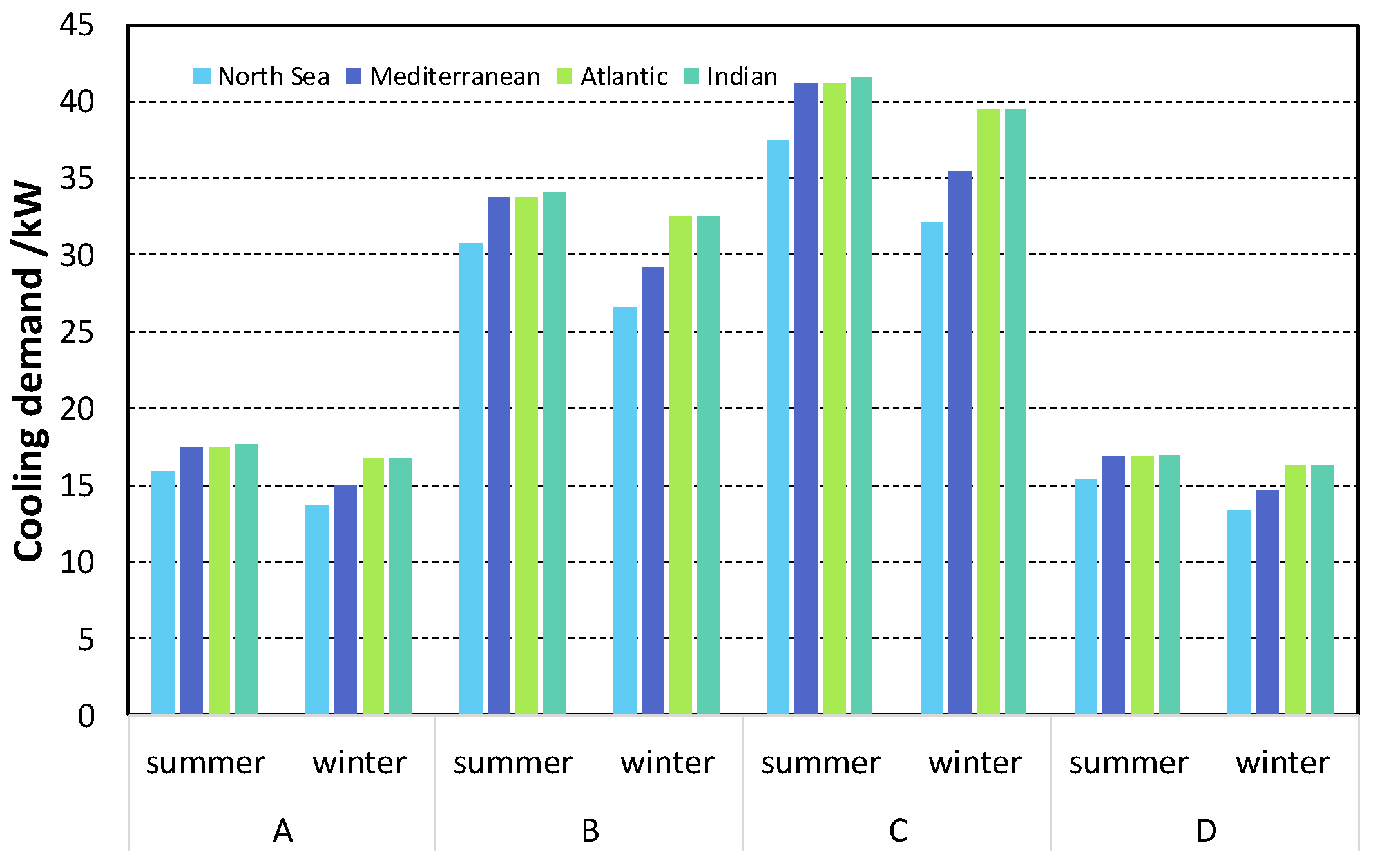
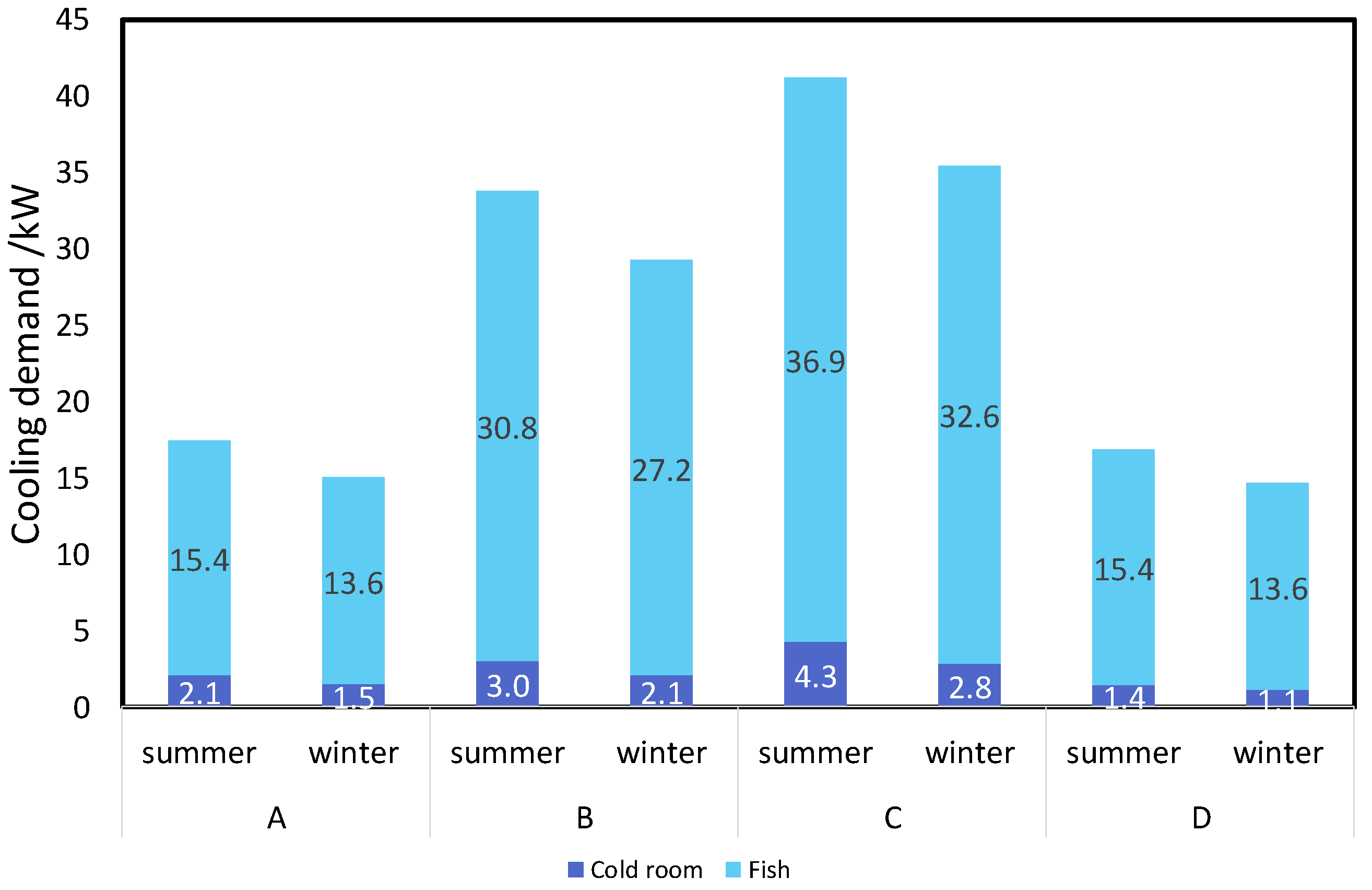
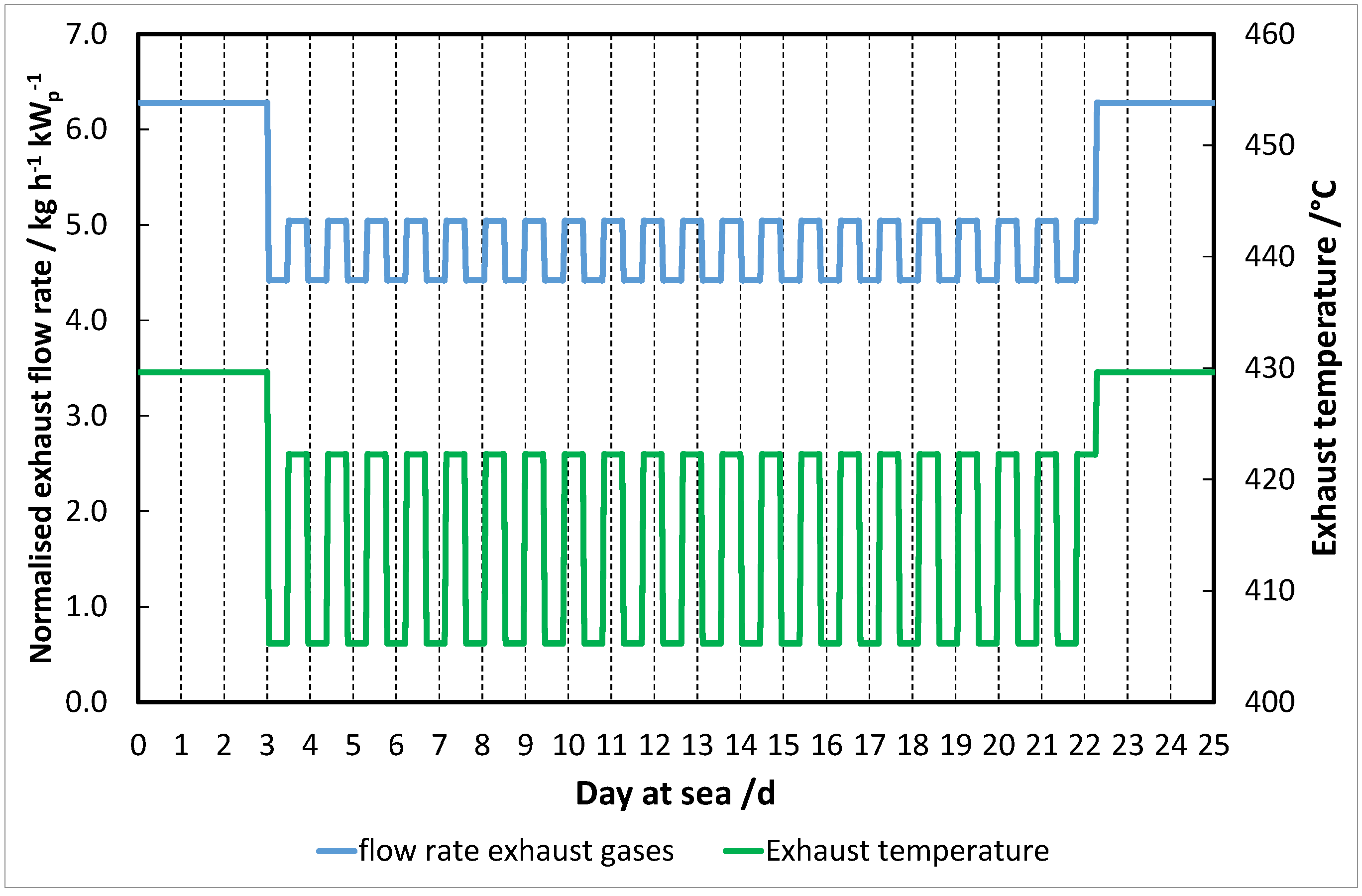

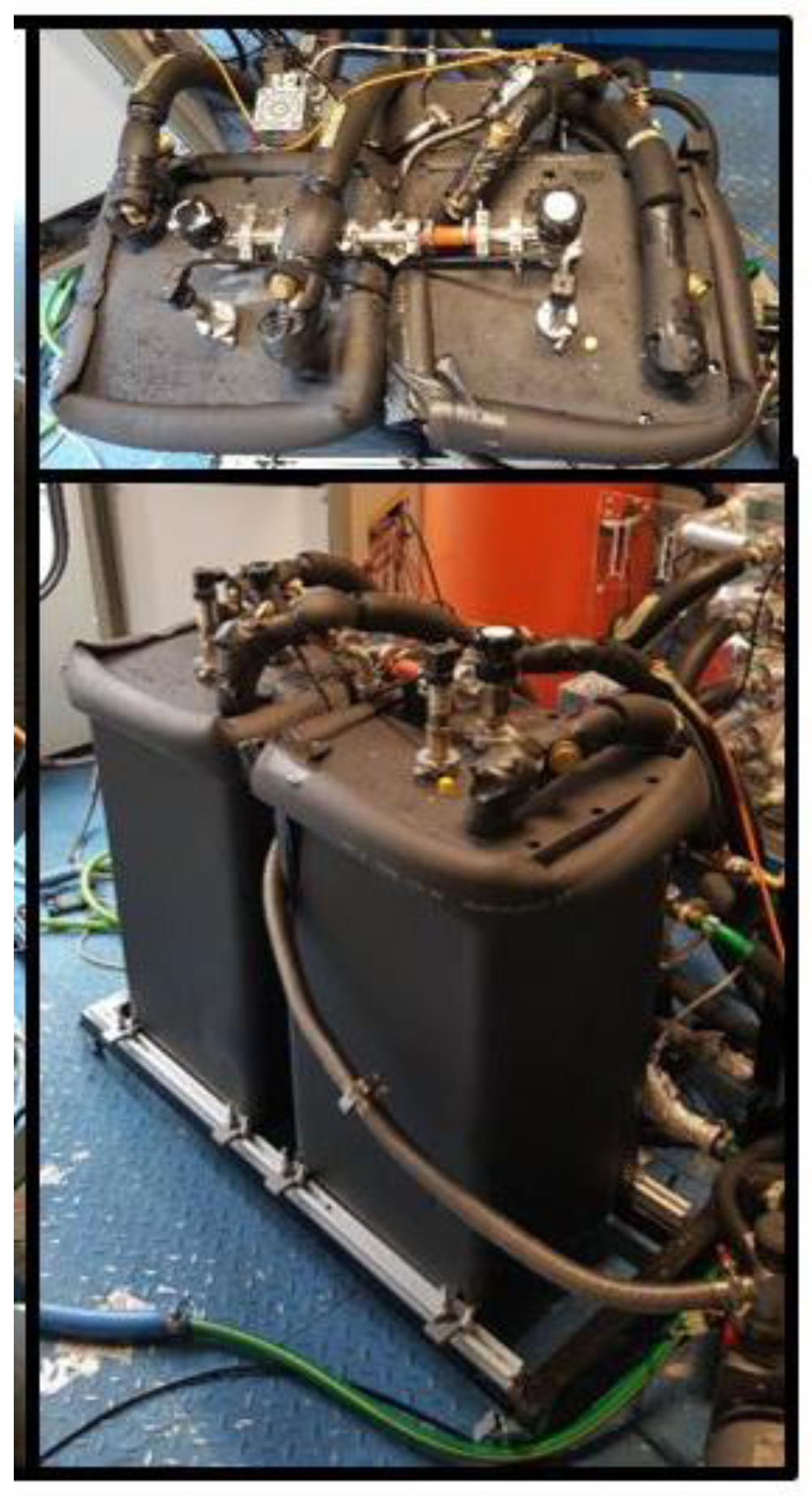

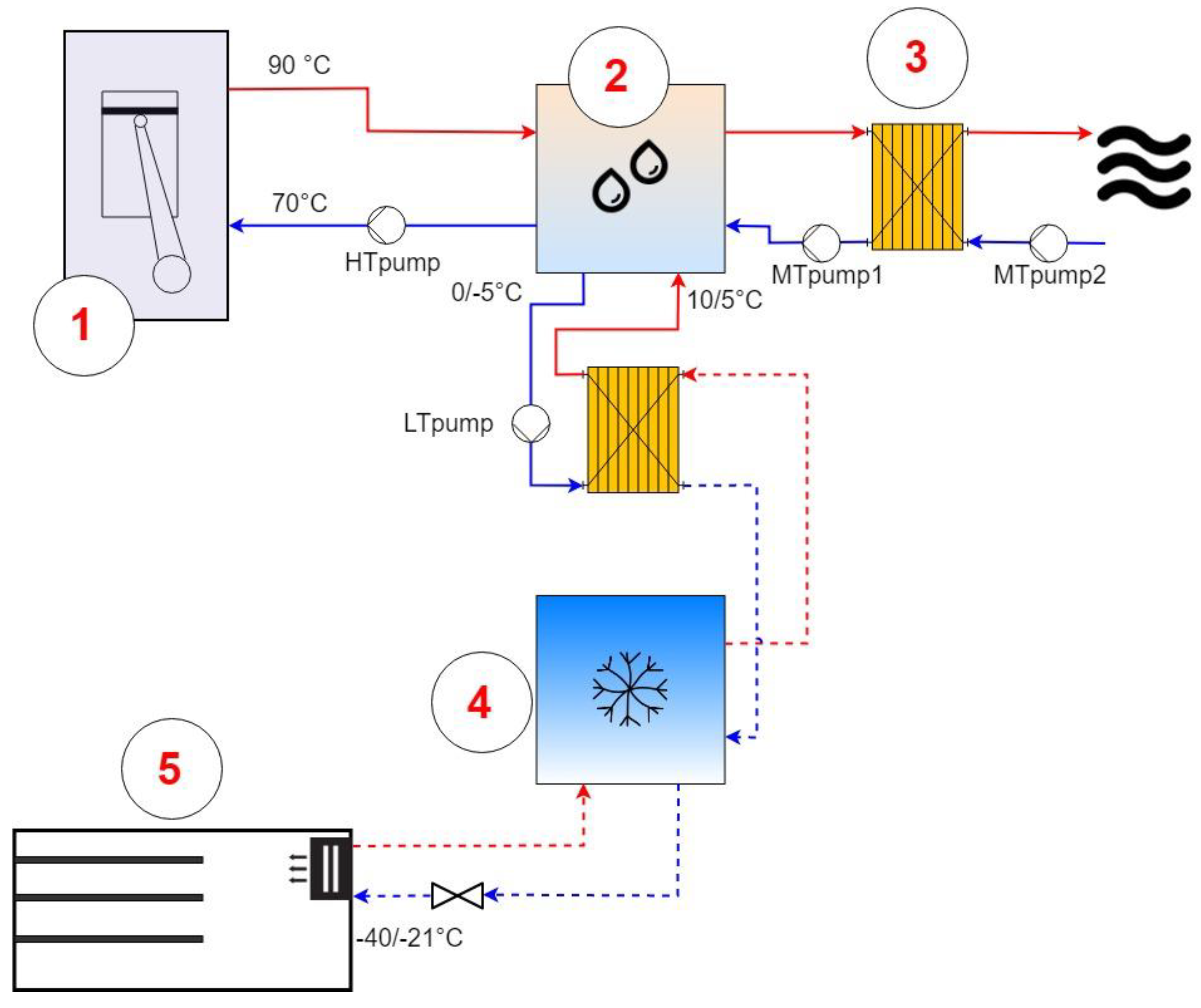
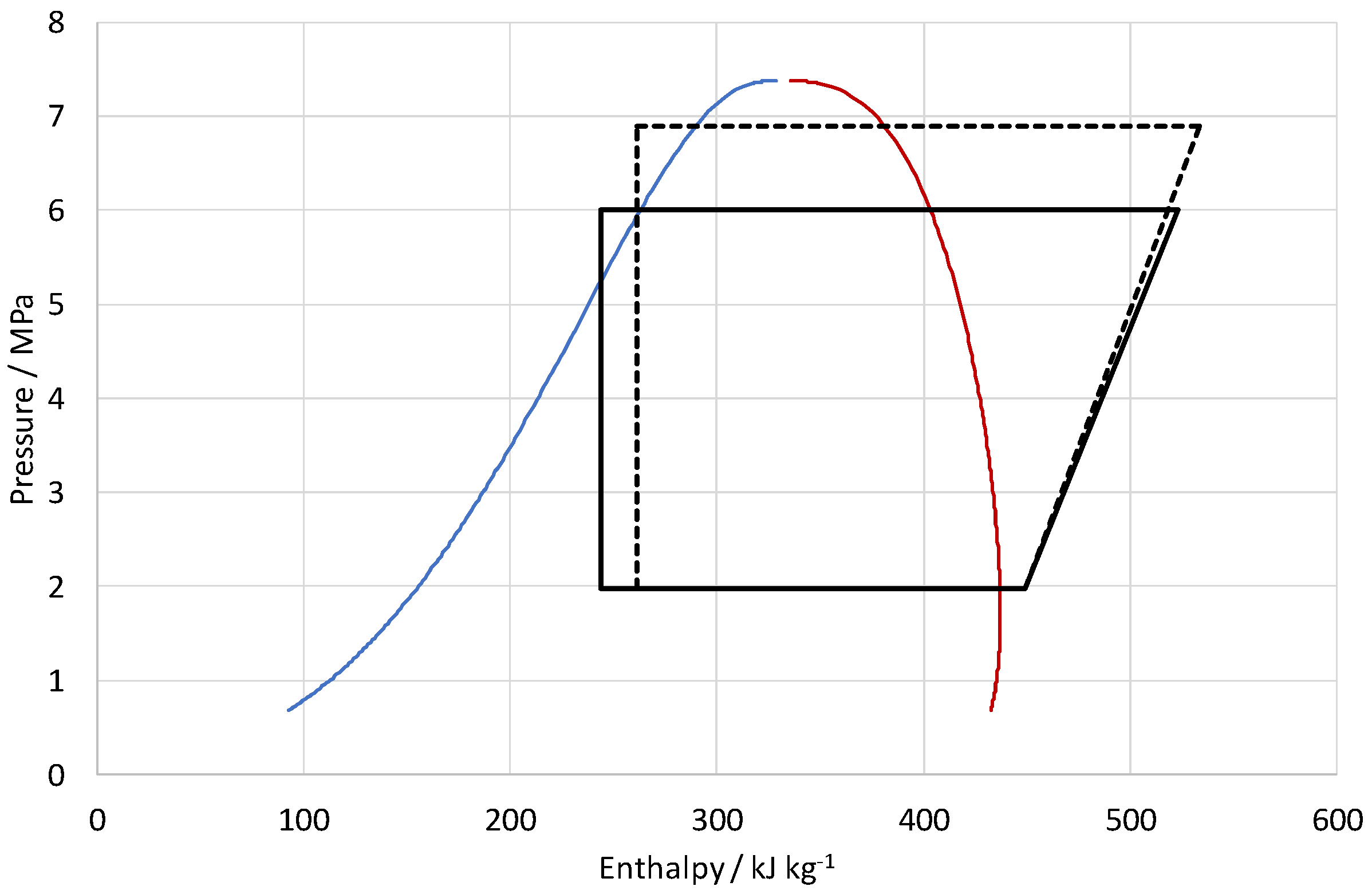

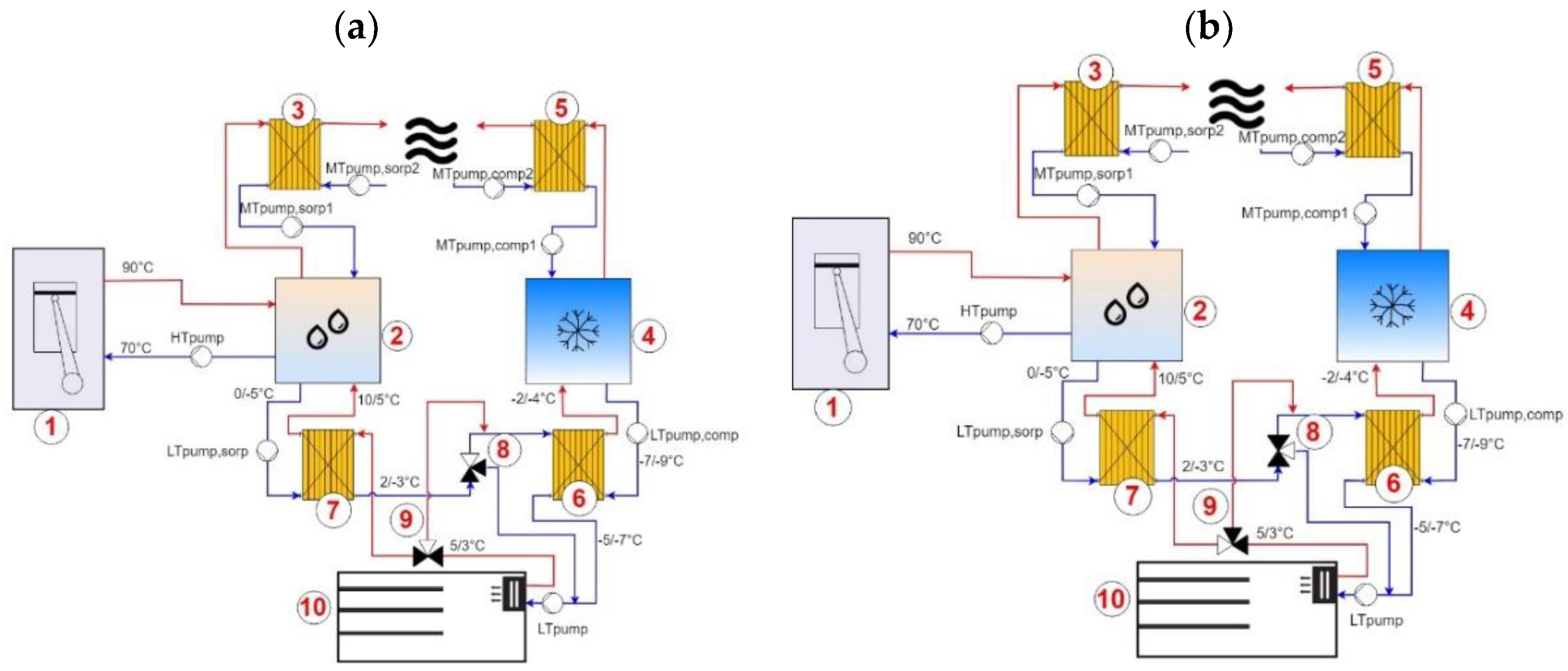

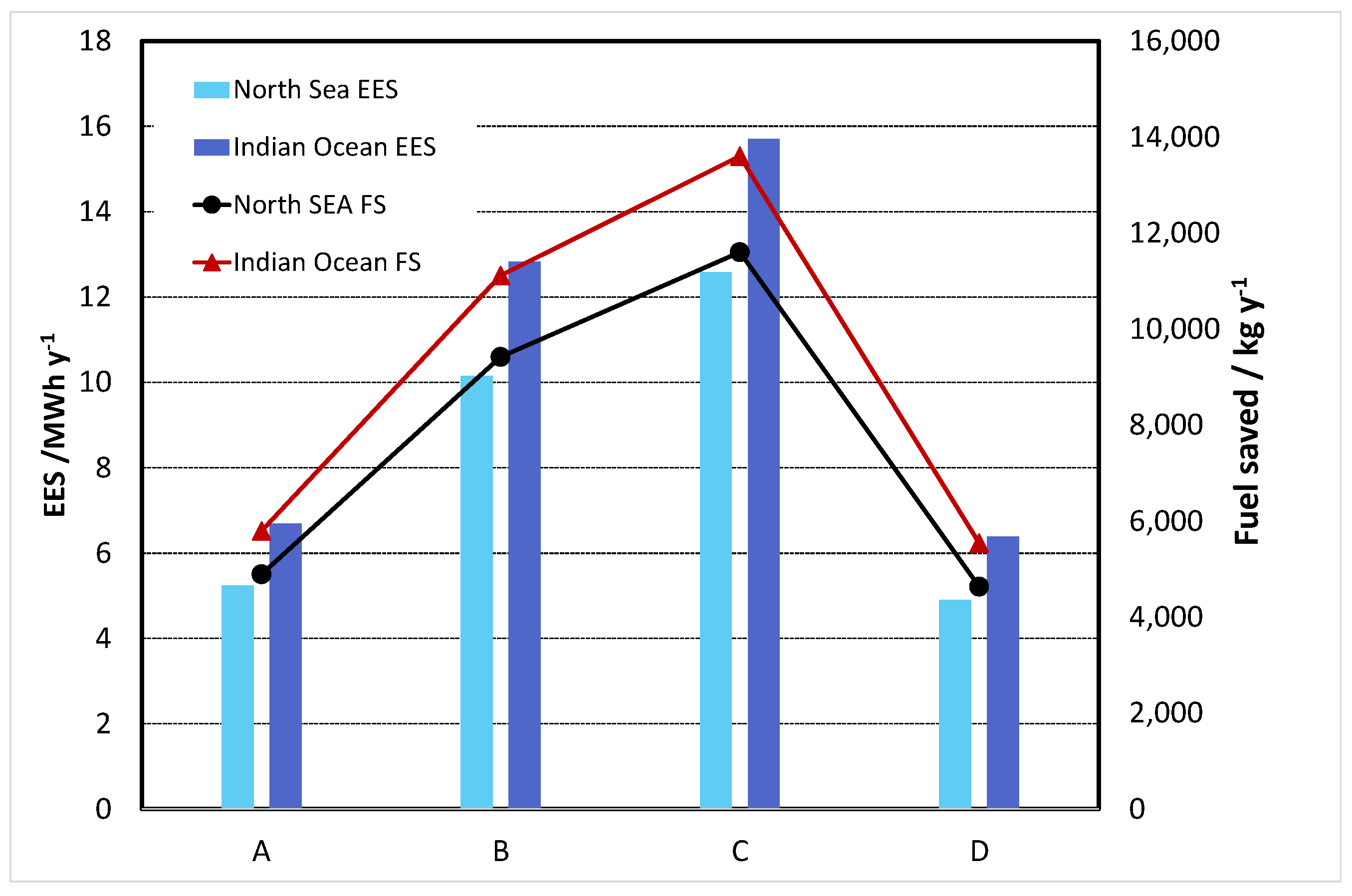
| Case | A | B | C | D |
|---|---|---|---|---|
| Loa × B × Dm | 15 × 4.5 × 1.6 | 18 × 6.0 × 2.0 | 20 × 6.9 × 2.5 | - |
| Fish hold capacity (m3) | 20 | 40 | 60 | 10 |
| Engine power (kW) | 250 | 425 | 500 | 190 |
| Fish stowing rate (kg/m3) | 500 | |||
| Fish amount max (t) | 10 | 20 | 30 | 5 |
| Days of operation | 20 | 20 | 25 | 10 |
| Fish caught daily (kg/d) | 500 | 1000 | 1200 | 500 |
| Displacement | 400 | 800 | 1000 | 300 |
| Incidence of refrigeration on engine consumption | 6% | 7% | 9% | 7% |
| Mediterranean Sea | North Sea | Atlantic Ocean | Indian Ocean | |
|---|---|---|---|---|
| Summer | 26 °C | 18 °C | 28 °C | 29 °C |
| Winter | 14 °C | 5 °C | 25 °C | 25 °C |
| Type of adsorbent | Activated carbon SRD 1352/3 (0.425–0.71 mm) |
| Total adsorbent mass | 4.8 kg |
| Adsorbers | 4 aluminium finned flat tubes heat exchangers connected in parallel for each adsorber |
| Total weight of adsorbers heat exchangers | 8 × 1.5 kg |
| Total weight of adsorber chambers | 36.3 kg each |
| Total volume of the adsorber chambers | 58 dm3 each |
| Condenser/Evaporator | 1 × finned tube Cu/SS heat exchanger |
| Total weight of cond/evap heat exchanger | 3.9 kg |
| Total weight of condenser/evaporator chambers | 13.9 kg each |
| Total volume of condenser/evaporator chamber | 13 dm3 each |
| Total weight of the prototype | 120 kg |
| Total volume of the prototype | 142 dm3 |
| Configuration | Evaporation Inlet Sorption | Cooling Water Inlet Sorption | Evaporation Inlet Compression | Condenser Compression | Heat Source Sorption |
|---|---|---|---|---|---|
| Cascade (CAS) | 5 | seawater | −20 | 0 | 90/200 |
| Cascade with pre-conditioning (CAS-PRE) | 5 | seawater | −20 | 0 | 90/200 |
| Direct expansion double effect (DIR-DOU) | −20 | seawater | - | - | 200 |
| Series hybrid (SER) | 5 | seawater | −2 | seawater | 90/200 |
| Configuration | Sorption System | COP | SCP (kW/kg) | Compression Refrigerant | EER |
|---|---|---|---|---|---|
| CAS | AC/ethanol | 0.06 | 75 (condenser inlet = 15 °C), 50 (condenser inlet = 22 °C), 35 (condenser inlet = 30 °C) | R744 | 3.6 (condenser inlet = 15 °C), 3.2 (condenser inlet = 22 °C), 2.5 (condenser inlet = 30 °C) |
| CAS-PRE | AC/ethanol | 0.06 | R744 | 3.2 (condenser inlet = 22 °C), 2.5 (condenser inlet = 30 °C) | |
| SER | AC/ethanol | 0.08 | R744 | 2.5 | |
| CAS | CaCl2/ammonia | 0.6 | 15 | R744 | 3.2 (condenser inlet = 22 °C), 2.5 (condenser inlet = 30 °C) |
| CAS-PRE | CaCl2/ammonia | 0.6 | 15 | R744 | 3.2 (condenser inlet = 22 °C), 2.5 (condenser inlet = 30 °C) |
| DIR-DOU | CaCl2/ammonia | 0.3 | 2 | R744 | - |
| SER | CaCl2/ammonia | 0.6 | 15 | R744 | 2.5 |
| Configuration | Sea | Sorption System | Fishing Vessel A | Fishing Vessel B | Fishing Vessel C | Fishing Vessel D |
|---|---|---|---|---|---|---|
| CAS | Mediterranean | AC/ethanol | <20% | <20% | <20% | <20% |
| CAS-PRE | Mediterranean | AC/ethanol | <20% | <20% | <20% | <20% |
| SER | Mediterranean | AC/ethanol | 100% | 80% | 80% | 30% |
| CAS | North Sea | AC/ethanol | <20% | <20% | <20% | <20% |
| CAS-PRE | North Sea | AC/ethanol | <20% | <20% | <20% | <20% |
| SER | North Sea | AC/ethanol | 100% | 100% | 100% | 35% |
| CAS | Indian Ocean | AC/ethanol | <20% | <20% | <20% | <20% |
| CAS-PRE | Indian Ocean | AC/ethanol | <20% | <20% | <20% | <20% |
| SER | Indian Ocean | AC/ethanol | 100% | 80% | 80% | 30% |
| CAS | Mediterranean | CaCl2/ammonia | 100% | 100% | 100% | 100% |
| CAS-PRE | Mediterranean | CaCl2/ammonia | 100% | 100% | 100% | 100% |
| DIR-DOU | Mediterranean | CaCl2/ammonia | 100% | 100% | 100% | 100% |
| SER | Mediterranean | CaCl2/ammonia | 100% | 100% | 100% | 100% |
| CAS | North Sea | CaCl2/ammonia | 100% | 100% | 100% | 100% |
| CAS-PRE | North Sea | CaCl2/ammonia | 100% | 100% | 100% | 100% |
| DIR-DOU | North Sea | CaCl2/ammonia | 100% | 100% | 100% | 100% |
| SER | North Sea | CaCl2/ammonia | 100% | 100% | 100% | 100% |
| CAS | Indian Ocean | CaCl2/ammonia | 100% | 100% | 100% | 100% |
| CAS-PRE | Indian Ocean | CaCl2/ammonia | 100% | 100% | 100% | 100% |
| DIR-DOU | Indian Ocean | CaCl2/ammonia | 100% | 100% | 100% | 100% |
| SER | Indian Ocean | CaCl2/ammonia | 100% | 100% | 100% | 100% |
| MTpump rated power consumption | 20 W/kWf |
| LT pump rated power cosumption | 23 W/kWf |
| HT pump rated power consumption | 27.3 W/kWf |
| MTsorp pump rated power consumption | 20 W/kWf |
| LTsorp pump rated power consumption | 10 W/kWf |
| EES % | North Sea | 71% | 71% | 71% | 71% |
| Indian | 73% | 73% | 73% | 73% |
| System | A | B | C | D | |
|---|---|---|---|---|---|
| North Sea | Cascade | 1.3 m3 | 2.4 m3 | 3.0 m3 | 1.2 m3 |
| Indian Ocean | Cascade | 1.5 m3 | 2.8 m3 | 3.4 m3 | 1.4 m3 |
| North Sea | Compression | 0.2 m3 | 0.4 m3 | 0.5 m3 | 0.2 m3 |
| Indian Ocean | Compression | 0.3 m3 | 0.5 m3 | 0.6 m3 | 0.3 m3 |
| Vessel | Sea | EES (MWh/y) | EES % | FS (kg/y) |
|---|---|---|---|---|
| A | Indian Ocean | 31 | 73% | 7872 |
| C | North Sea | 59 | 71% | 15,021 |
| Configuration | Sea | Avoided CO2 Emissions (t/y) | |||
|---|---|---|---|---|---|
| A | B | C | D | ||
| Cascade | North Sea | 4.0 | 7.7 | 9.4 | 3.8 |
| Indian | 4.7 | 9.0 | 11.1 | 4.5 | |
| Series | North Sea | - | - | 19.5 | - |
| Indian Ocean | 10.2 | - | - | - | |
© 2019 by the authors. Licensee MDPI, Basel, Switzerland. This article is an open access article distributed under the terms and conditions of the Creative Commons Attribution (CC BY) license (http://creativecommons.org/licenses/by/4.0/).
Share and Cite
Palomba, V.; Dino, G.E.; Ghirlando, R.; Micallef, C.; Frazzica, A. Decarbonising the Shipping Sector: A Critical Analysis on the Application of Waste Heat for Refrigeration in Fishing Vessels. Appl. Sci. 2019, 9, 5143. https://doi.org/10.3390/app9235143
Palomba V, Dino GE, Ghirlando R, Micallef C, Frazzica A. Decarbonising the Shipping Sector: A Critical Analysis on the Application of Waste Heat for Refrigeration in Fishing Vessels. Applied Sciences. 2019; 9(23):5143. https://doi.org/10.3390/app9235143
Chicago/Turabian StylePalomba, Valeria, Giuseppe E. Dino, Robert Ghirlando, Christopher Micallef, and Andrea Frazzica. 2019. "Decarbonising the Shipping Sector: A Critical Analysis on the Application of Waste Heat for Refrigeration in Fishing Vessels" Applied Sciences 9, no. 23: 5143. https://doi.org/10.3390/app9235143







